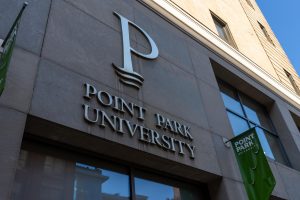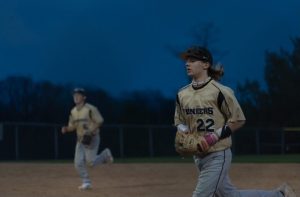When called to cover a mining accident, Michael Fuoco had no idea it would wind up being one of his greatest journalistic achievements.In “The Confessor,” he detailed a detective’s drive to nail a man who murdered an 11-year-old boy.While writing “A Soldier’s Heart,” he captured the stories of four soldiers suffering from post-traumatic stress disorder.With 34 years in the newspaper business, Fuoco has experienced the best and worst of humanity. He is preparing to share his expertise and skill with the Point Park University community as an adjunct professor of journalism next semester.”One reason I like to teach is because I always have something to say,” Fuoco said, adding that “it keeps you in tune with younger generations.”Fuoco spent his early years at Mon Valley Catholic High School in Chardon, Oh. He played football, badly, according to him, ran track and served as vice president of his senior class. But it was his time working on the school newspaper that left a mark on him. It was then that he recognized his skill of writing and developed a passion for the written word.After high school, he attended John Carroll University for journalism where he encountered the first bizarre journalistic moment of his career in his very first interview.”I had just signed up to be on the college newspaper and there was a small fire in the girls’ dormitory,” he said. He had to interview a priest who was in charge of the particular dorm that caught fire.Fuoco recalls being nervous, worried about what questions he was going to ask.”I thought this was the big time,” he said.When Fuoco knocked on the priest’s door, the priest told him, from a separate room, to come inside and take a seat.”I sit down and in he walks, stark f—ing naked,” Fuoco said, straight-faced, “[I thought], this was my first interview, maybe all interviews are done in the nude.” Fuoco conducted the interview while covering his face with his notebook as the priest sat the entire time without any clothes on.”I hope my next interview’s with a woman,” Fuoco remembers thinking. Fuoco spent a lot of his college life as a “hippie,” with long hair and blue jeans, both “flags” at the time of being against the war and government. The Kent State University massacre, in which four students were gunned down by the Ohio National Guard, occurred his freshman year in May 1970.The event set off a series of residual protest violence at John Carroll, which is located about 30 miles from Kent State. There were fires and bomb threats on campus. There were times when Fuoco thought the world was coming to an end.Fuoco’s style caused him grief. He’d be refused service at restaurants and was almost beaten up, all because people believed he was tied to the anti-war effort and caused violence on campus, which he did not.”It reinforced to me that I wanted to do something with truth. Truth was part of what I did…and that’s why I’m a newspaper writer.”Although he is also both a journalist and a reporter, “writer” is the word Fuoco always uses when talking about himself. He recognizes the terms are not mutually exclusive, but writing, he said, is what he does.In 1975, Fuoco started his career at the Daily Herald, a now-defunct publication based in Monessen, Pa.. He moved on to the Valley Independent and has been a staff writer at the Post-Gazette since 1984. He is currently on the enterprise reporting team, and serves as a leader for the Post-Gazette unit of the Newspaper Guild union. At the Post-Gazette, Fuoco has covered a wide array of stories, from the murders of drug dealers to the deaths of five children in a house fire, and from advancements in fingerprinting technology to the violent protests of Pittsburgh’s G-20. One of his most memorable assignments was covering the miraculous rescue at Quecreek Mine in Somerset County when all nine trapped miners were found alive and rescued. News of their survival broke on Fuoco’s birthday, and he was there to report it. “It was one of the most exciting stories,” he said. A large, framed poster of the Post-Gazette’s front-page that features his story hangs in the publication’s newsroom to this day. Fuoco’s reportage was included in “All Nine Alive,” a book about the rescue that was compiled from stories and photos sourced directly from the pages of the paper. Fuoco is well-known for the time he spent covering the Pittsburgh Police beat, a stint that lasted from 1988 to 1999 and intermittently thereafter.He was a police reporter at a time when Pittsburgh was becoming increasingly violent. When he started, there were around 20 homicides in a year. As time progressed, there were closer to ninety. “I was writing about three stories a day,” he said. The nature of his assignment put Fuoco in danger on many occasions. When he was with police on a scene, he stayed near them, and when they left, so did he – usually.










